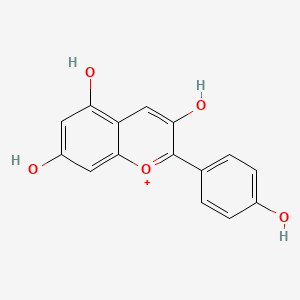| MeSH term | MeSH ID | Detail |
|---|---|---|
| Cystitis | D003556 | 23 associated lipids |
| Parkinsonian Disorders | D020734 | 20 associated lipids |
Pelargonidin
Pelargonidin is a lipid of Polyketides (PK) class. The involved functions are known as Uptake, Intestinal Absorption, glucose uptake, Process and Metabolic Inhibition. Pelargonidin often locates in Serosal, Mucous Membrane, brush border membrane, Membrane and Cell surface. The associated genes with Pelargonidin are SLC5A1 gene, SLC2A2 gene, Homologous Gene, F3 gene and CRSP3 gene. The related experimental models are Knock-out.
Cross Reference
Introduction
To understand associated biological information of Pelargonidin, we collected biological information of abnormalities, associated pathways, cellular/molecular locations, biological functions, related genes/proteins, lipids and common seen animal/experimental models with organized paragraphs from literatures.
What diseases are associated with Pelargonidin?
There are no associated biomedical information in the current reference collection.
Possible diseases from mapped MeSH terms on references
We collected disease MeSH terms mapped to the references associated with Pelargonidin
PubChem Associated disorders and diseases
What pathways are associated with Pelargonidin
There are no associated biomedical information in the current reference collection.
PubChem Biomolecular Interactions and Pathways
Link to PubChem Biomolecular Interactions and PathwaysWhat cellular locations are associated with Pelargonidin?
Visualization in cellular structure
Associated locations are in red color. Not associated locations are in black.
Related references are published most in these journals:
| Location | Cross reference | Weighted score | Related literatures |
|---|
What functions are associated with Pelargonidin?
Related references are published most in these journals:
| Function | Cross reference | Weighted score | Related literatures |
|---|
What lipids are associated with Pelargonidin?
There are no associated biomedical information in the current reference collection.
What genes are associated with Pelargonidin?
Related references are published most in these journals:
| Gene | Cross reference | Weighted score | Related literatures |
|---|
What common seen animal models are associated with Pelargonidin?
Knock-out
Knock-out are used in the study 'MATE2 mediates vacuolar sequestration of flavonoid glycosides and glycoside malonates in Medicago truncatula.' (Zhao J et al., 2011).
Related references are published most in these journals:
| Model | Cross reference | Weighted score | Related literatures |
|---|
NCBI Entrez Crosslinks
All references with Pelargonidin
Download all related citations| Authors | Title | Published | Journal | PubMed Link |
|---|---|---|---|---|
| El Mohsen MA et al. | Absorption, tissue distribution and excretion of pelargonidin and its metabolites following oral administration to rats. | 2006 | Br. J. Nutr. | pmid:16441916 |
| Harnly JM et al. | Flavonoid content of U.S. fruits, vegetables, and nuts. | 2006 | J. Agric. Food Chem. | pmid:17177529 |
| Longo L and Vasapollo G | Determination of anthocyanins in Ruscus aculeatus L. berries. | 2005 | J. Agric. Food Chem. | pmid:15656691 |
| Irani NG and Grotewold E | Light-induced morphological alteration in anthocyanin-accumulating vacuoles of maize cells. | 2005 | BMC Plant Biol. | pmid:15907203 |
| Lorenc-Kukuła K et al. | Ectopic expression of anthocyanin 5-o-glucosyltransferase in potato tuber causes increased resistance to bacteria. | 2005 | J. Agric. Food Chem. | pmid:15656661 |
| Garcia-Alonso M et al. | Electron spin resonance spectroscopy studies on the free radical scavenging activity of wine anthocyanins and pyranoanthocyanins. | 2005 | Mol Nutr Food Res | pmid:16254886 |
| Mylnikov SV et al. | Rubus fruit juices affect lipid peroxidation in a Drosophila melanogaster model in vivo. | 2005 | J. Agric. Food Chem. | pmid:16190624 |
| Longo L et al. | Identification of anthocyanins in Rhamnus alaternus L. berries. | 2005 | J. Agric. Food Chem. | pmid:15740065 |
| Tian Q et al. | Probing anthocyanin profiles in purple sweet potato cell line (Ipomoea batatas L. Cv. Ayamurasaki) by high-performance liquid chromatography and electrospray ionization tandem mass spectrometry. | 2005 | J. Agric. Food Chem. | pmid:16076141 |
| Hou DX et al. | Anthocyanidins inhibit cyclooxygenase-2 expression in LPS-evoked macrophages: structure-activity relationship and molecular mechanisms involved. | 2005 | Biochem. Pharmacol. | pmid:15963474 |
| Habermeyer M et al. | Anthocyanidins modulate the activity of human DNA topoisomerases I and II and affect cellular DNA integrity. | 2005 | Chem. Res. Toxicol. | pmid:16167831 |
| Wu X and Prior RL | Identification and characterization of anthocyanins by high-performance liquid chromatography-electrospray ionization-tandem mass spectrometry in common foods in the United States: vegetables, nuts, and grains. | 2005 | J. Agric. Food Chem. | pmid:15826066 |
| Wu X and Prior RL | Systematic identification and characterization of anthocyanins by HPLC-ESI-MS/MS in common foods in the United States: fruits and berries. | 2005 | J. Agric. Food Chem. | pmid:15796599 |
| Zhang Y et al. | Human tumor cell growth inhibition by nontoxic anthocyanidins, the pigments in fruits and vegetables. | 2005 | Life Sci. | pmid:15680311 |
| Jayaprakasam B et al. | Insulin secretion by bioactive anthocyanins and anthocyanidins present in fruits. | 2005 | J. Agric. Food Chem. | pmid:15631504 |
| Shih PH et al. | Effects of anthocyanidin on the inhibition of proliferation and induction of apoptosis in human gastric adenocarcinoma cells. | 2005 | Food Chem. Toxicol. | pmid:15964118 |
| Tian Q et al. | Screening for anthocyanins using high-performance liquid chromatography coupled to electrospray ionization tandem mass spectrometry with precursor-ion analysis, product-ion analysis, common-neutral-loss analysis, and selected reaction monitoring. | 2005 | J Chromatogr A | pmid:16395794 |
| Nielsen AH et al. | Flavonoids in flowers of 16 Kalanchoë blossfeldiana varieties. | 2005 | Phytochemistry | pmid:16297414 |
| Wu X et al. | Pelargonidin is absorbed and metabolized differently than cyanidin after marionberry consumption in pigs. | 2004 | J. Nutr. | pmid:15465754 |
| Xie DY et al. | Molecular and biochemical analysis of two cDNA clones encoding dihydroflavonol-4-reductase from Medicago truncatula. | 2004 | Plant Physiol. | pmid:14976232 |
